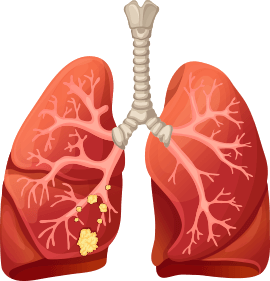
ON ITS ORIGIN


The location in the lung where cancer started determines its type:
- 1 -
Non-small cell lung cancer (NSCLC)

Adenocarcinoma
(most common form, starts in the mucus making gland cells in the lining of the airways)

Squamous Cell Carcinoma
(develops in the flat cells that cover the surface of the airway and tends to grow near the centre of the lung)

Large Cell Carcinoma
(appears large and round under a microscope)
- 2 -
Small cell lung cancer (SCLC)
The stages of lung cancer depend on whether the cancer is local or has spread from the lungs to lymph nodes or other organs. Because the lungs are large, tumors can grow in them for a long time before they are found. Even when symptoms do occur, people think they are due to other causes so early-stage lung cancer is difficult to detect.
Stages Of Non-Small Cell Lung Cancer (NSCLC):

Stage I
The cancer is located only in the lungs and has not spread to the lymph nodes.

Stage II
The cancer is in the lung and nearby lymph nodes.

Stage III
The cancer is found in the lung and in the lymph nodes in the middle of the chest, also described as locally advanced disease.

Stage IV
This is the most advanced stage of lung cancer where the cancer has spread to both lungs, to fluid in the area around the lungs, or to another part of the body, such as the liver or other organs.
Stages Of Small Cell Lung Cancer (SCLC):[4]

Limited Stage
In this stage, cancer is found on one side of the chest, involving just one part of the lung and nearby lymph nodes.

Extensive Stage
In this stage, cancer has spread to other regions of the chest or other parts of the body.
LUNG CANCER CAN BE DETECTED NON-INVASIVELY WITH A LIQUID BIOPSY
More than two-thirds of all lung cancer patients are diagnosed at a late stage when tumours are present in more than one site in the body. Despite recent advances, 5-year survival rates for lung cancer (both NSCLC & SCLC) are still poor when compared with other common cancers, particularly in later stages. As with many other types of cancer, the earlier a patient is diagnosed the greater their chance of survival.[7]
1. International Agency for Research on Cancer, World Health Organization. Cancer Fact Sheets: Lung Cancer, Available at: http://gco.iarc.fr/today/data/pdf/fact- sheets/cancers/cancer-fact-sheets-11.pdf (Accessed: November 2019).
2. Ferlay J, Ervik M, Lam F, Colombet M, Mery L, Piñeros M, Znaor A, Soerjomataram I,Bray F (2018). Global Cancer Observatory: Cancer Today. Lyon, France: International Agency for Research on Cancer.
3. WHO. http://www.who.int/mediacentre/factsheets/fs297/en/. Calculation - 1.59 million deaths per year / 365 days – 4,356 deaths per day / 24 hours = 181 deaths per hour / 60 minutes = 3 deaths per minute
4. https://www.cancerresearchuk.org/about-cancer/lung-cancer/stages-types-grades/types
5. SEER Cancer Stat Facts: Lung and Bronchus Cancer. National Cancer Institute. Bethesda, MD, https://seer.cancer.gov/statfacts/html/lungb.html
6. CancerCare. Types and Staging of Lung Cancer, Available at: https://www.lungcancer.org/find_information/publications/163-lung_cancer_101/268-types_and_staging (Accessed: November 2019).
7. Midthun DE. Early detection of lung cancer. F1000Res. 2016;5:F1000 Faculty Rev-739. Published 2016 Apr 25. doi:10.12688/f1000research.7313.1
8. https://gco.iarc.fr/today/data/factsheets/populations/356-india-fact-sheets.pdf